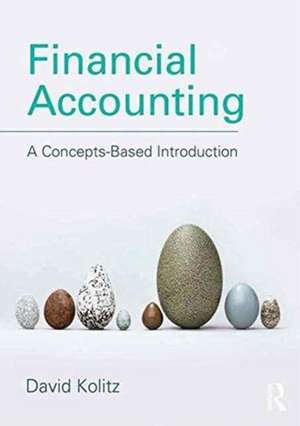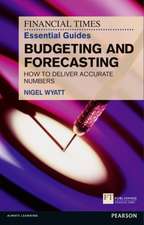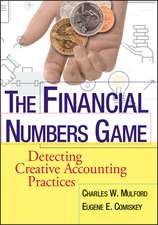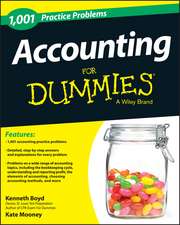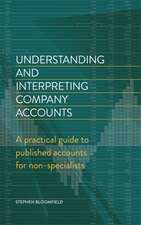Financial Accounting: A Concepts-Based Introduction
Autor David Kolitzen Limba Engleză Paperback – 12 dec 2016
This international edition includes extracts from financial statements, definitions of key terms and exam examples. Unlike other textbooks, the author provides analysis of why accountants do what they do, and not just how. With such a wealth of accounting models and diagrams intertwined with this analysis, this book guides the reader through all the practicalities and concepts of financial accounting. Additional online questions, exercises and problems provide an opportunity to put this new-found knowledge into practice along the way.
This book is an essential guide for students new to accountancy, and an equally useful tool for more experienced students and researchers.
| Toate formatele și edițiile | Preț | Express |
|---|---|---|
| Paperback (1) | 509.75 lei 6-8 săpt. | |
| Taylor & Francis – 12 dec 2016 | 509.75 lei 6-8 săpt. | |
| Hardback (1) | 1056.84 lei 6-8 săpt. | |
| Taylor & Francis – 13 dec 2016 | 1056.84 lei 6-8 săpt. |
Preț: 509.75 lei
Preț vechi: 599.71 lei
-15% Nou
Puncte Express: 765
Preț estimativ în valută:
97.54€ • 102.31$ • 81.20£
97.54€ • 102.31$ • 81.20£
Carte tipărită la comandă
Livrare economică 01-15 aprilie
Preluare comenzi: 021 569.72.76
Specificații
ISBN-13: 9781138844971
ISBN-10: 1138844977
Pagini: 622
Ilustrații: 136
Dimensiuni: 174 x 246 x 36 mm
Greutate: 1.02 kg
Ediția:1
Editura: Taylor & Francis
Colecția Routledge
Locul publicării:Oxford, United Kingdom
ISBN-10: 1138844977
Pagini: 622
Ilustrații: 136
Dimensiuni: 174 x 246 x 36 mm
Greutate: 1.02 kg
Ediția:1
Editura: Taylor & Francis
Colecția Routledge
Locul publicării:Oxford, United Kingdom
Public țintă
Postgraduate and UndergraduateCuprins
Part 1: A Conceptual Overview 1. The Accounting Environment 2. Fundamental Accounting Concepts 3. The Accounting Equation and the Analysis of Transactions Part 2: The Accounting Process 4. Recording External Transactions 5. Recording Internal Transactions 6. Preparation and Presentation of Financial Statements 7. Closing Entries Part 3: The Accounting Process Explained 8. Purchase and Sale Transactions 9. Analysis Journals Part 4: Recognition and Measurement of the Elements of the Financial Statements 10. Property, Plant and Equipment 11. Inventory and Cost of Sales 12. Accounts Receivable 13. Cash and Bank 14. Accounts Payable 15. Owner's Equity and Non-Current Liabilities Part 5: Entity Forms 16. Partnerships 17. Companies Part 6: Sundry Topics 18. Statement of Cash Flows 19. Analysis of Financial Statements 20. Non-Business Entities 21. Incomplete Records
Recenzii
'A very convenient and easy way into the complex material of accounting ... with its useful features, examples, and structure, [the book offers] a very diverse learning package. This book is a positive contribution to the literature.' - Christiane Pott, International Journal of Accounting
'Written in a very friendly, easy-to-read style, this excellent financial accounting text will suit beginners as well as more experienced learners. Comprehensive and up-to-date, it enables readers to explore different angles of financial reporting. It makes good use of a number of relevant contemporary examples, which helps with maintaining student motivation.' - Dr Petros Vourvachis, Lecturer in Financial Accounting, Loughborough University, UK
'Written in a very friendly, easy-to-read style, this excellent financial accounting text will suit beginners as well as more experienced learners. Comprehensive and up-to-date, it enables readers to explore different angles of financial reporting. It makes good use of a number of relevant contemporary examples, which helps with maintaining student motivation.' - Dr Petros Vourvachis, Lecturer in Financial Accounting, Loughborough University, UK
Descriere
Financial accounting is a key building block to understanding accounting more generally. This textbook helps students to understand the concepts that underpin the application of accounting theory to help solve accounting problems. This international edition includes extracts from financial statements, definitions of key terms and exam examples, along with real life examples to support class work. Unlike other textbooks, the author provides analysis of why accountants do what they do and not just how.
This is an essential read for all accountancy and financing students and researchers.
This is an essential read for all accountancy and financing students and researchers.
